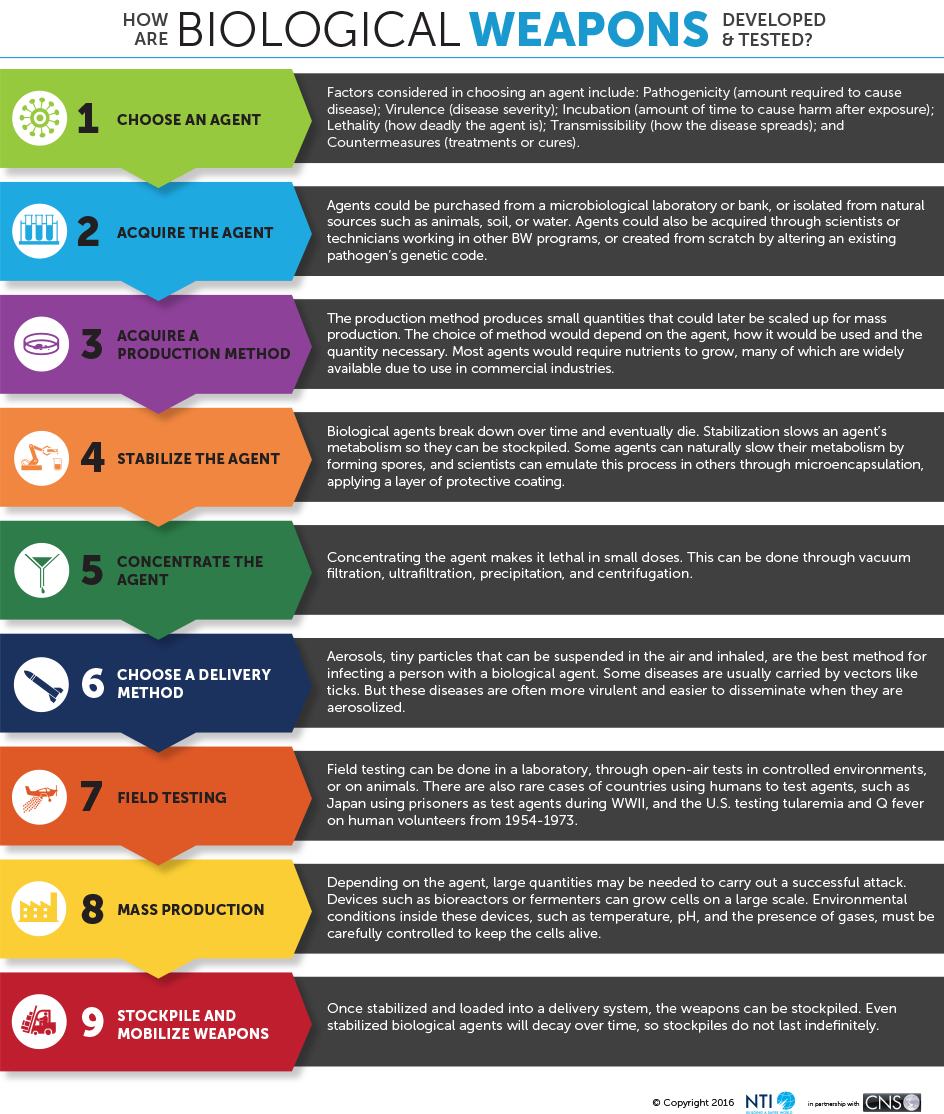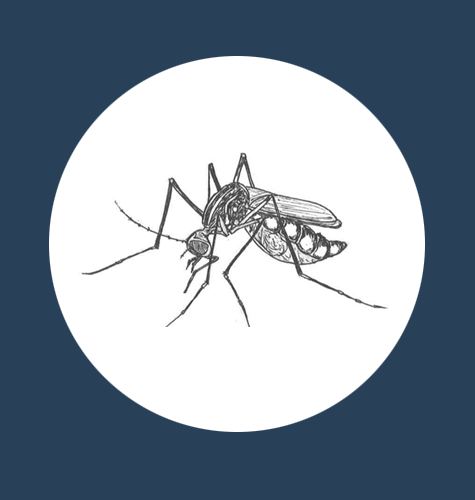1. How are biological weapons developed and tested?

2. How difficult is it for states to acquire biological weapons?
- Given the dual-use nature of biotechnology, most countries with pharmaceutical and medical industries have the technical capability to produce biological weapons. The global explosion of the biotechnology and pharmaceutical industries will increase the number of countries with this potential.
- Some analysts argue that tacit knowledge―the experience gained only through past hands-on experience with biological agents―is a tremendous asset, without which it can be difficult to launch a biological weapons program. [1] However, advances in biotechnology have increased automation of certain procedures, reducing scientific training requirements.
- Developing an effective BW agent delivery system, such as cluster munitions, can be extremely difficult. This is particularly true when the agent selected for dissemination is not naturally resilient to environmental and physical stresses.
3. How are biological weapons delivered to a target?
4. What are the effects of biological weapons?
- The effects of biological weapons depend on the type, quality, and quantity of the agents employed, and the effectiveness of the delivery systems, as well as the conditions under which attacks are carried out. [2]
- Some diseases, such as plague and smallpox, are contagious. Others, such as anthrax, do not spread person-to-person. [3]
- The Centers for Disease Control (CDC) separates potential bioterrorism agents that cause infections in humans into three categories: A, B, and C. [4] There are also potential agents that cause infection in livestock or crops. Biological weapons can have a major effect not just in terms of physical casualties, but also in terms of social disruption, economic losses, and environmental damage.
Category A |
|
Bacillus anthracis (anthrax) Clostridium botulinum toxin (botulism) Yersinia pestis (plague) Variola major (tularemia) Francisella tularensis (smallpox) Ebola and other viral hemorrhagic fevers |
Category B |
|
Brucella species (brucellosis) Coxiella burnetii (Q fever) Ricin toxin Vibrio cholerae (cholera) |
Category C |
|
Emerging infectious diseases such as Nipah virus and hantavirus Influenza |
5. Can biological weapons be stockpiled?
- If properly maintained, biological weapons can be stored for decades.
- Because biological warfare agents are living organisms, many will decay quickly if exposed to adverse environmental conditions. Unless an agent is to be used shortly after production, most agents will need to be stabilized in order to withstand the stresses of storage, transport, and dissemination.
- Most stabilization methods involve freezing and/or dehydration in order to slow down agents’ metabolism. Many of these methods are widely used in the pharmaceutical industry and to produce a variety of commercial products.
- Some microorganisms, such as Bacillus anthracis (anthrax), can naturally slow their metabolisms by forming dormant spores. This natural process can be emulated in a laboratory by applying a coat of protective material to certain pathogens and toxins through a stabilization method known as microencapsulation.
- State-run programs traditionally stockpiled bioweapons to ensure their militaries could quickly access them if needed. The Soviet program, however, also maintained facilities that were capable of producing large agent quantities on demand. [4] Recent and future technological advances could enable ostensibly peaceful-use activities to be more readily converted to military use, facilitating smaller-scale, more controlled, on-demand production, and obviating the need for industrial-scale production, and extensive stockpiling. Such developments are likely to pose serious nonproliferation verification challenges.
6. Are there effective defenses or cures to counter biological weapons use?
There are measures that can mitigate the consequences of a biological attack. Many of these defenses are agent-specific. Most vaccines, for example, only work against one pathogen, and developing them is an expensive undertaking. However, a robust biodefense program combined with appropriate public health measures can help a country to minimize the effects of a biological attack. Key measures include:
Protection
|
Detection
|
Medical Countermeasures
|
Decontamination
|
Sources
[1] See, for example, James Revill and Catherine Jefferson, “Tacit knowledge and the biological weapons regime,” Science and Public Policy (2014) 41 (5): 597-610; Kathleen Vogel, “Bioweapons Proliferation: Where Science Studies and Public Policy Collide,” Social Studies of Science (October 2006) vol. 36 (5): 659-690.
[2] Centers for Disease Control and Prevention, “Anthrax – Basic Information- How People are Infected,” http://www.cdc.gov/anthrax/basics/how-people-are-infected.html. September 1, 2015
[3] Centers for Disease Control and Prevention, “Bioterrorism Agents/Diseases,” http://www.bt.cdc.gov/agent/agentlist-category.asp.
[4] Mark A. Prelas and Michael Peck, Nonproliferation Issues for Weapons of Mass Destruction, (Boca Raton, FL: CRC Press, 2005), p. 46.
Photo Credit
Header Image: Drills conducted in full chemical protective gear. Source: U.S. Navy via WikiMedia Commons.









